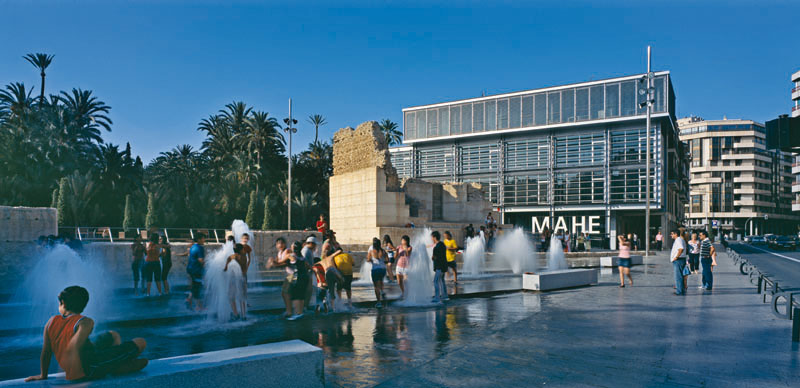

|
Edificio de oficinas PIMESA y entorno del Museu Arqueologic i d’Historia d’Elx- (MAHE)
Pimesa office building and environs of the Archaeology and History
Museum of Elx (MAHE) Arquitectos/Architects:
|
|
|
|
Situación/Location:
Promotor/Developer:
Colaboradores/Collaborators:
Constructora/Contractor:
Aparejadores/Surveyors:
Estructura/Structural:
Fotógrafo/Photographer: |
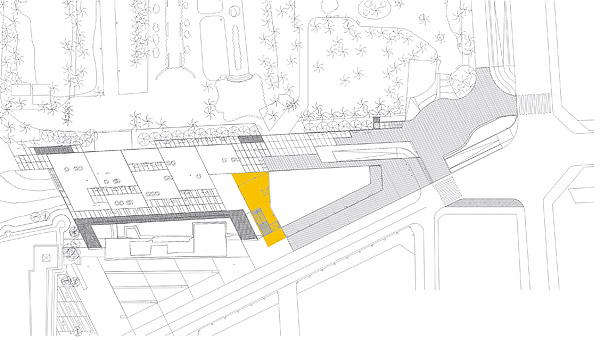 |
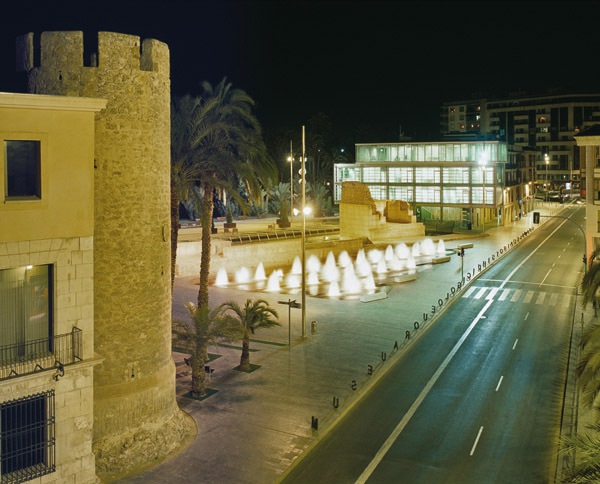 |
|
|
En 1997 el Ayuntamiento de Elche nos
encarga la redacción del proyecto básico de ordenación y urbanización de la
Plaza del Palacio junto al Alcázar de su Señoría.
En el transcurso de las excavaciones arqueológicas se exhumaron el lienzo de la muralla almohade y el acueducto de la acequia mayor del pantano que abastecía de agua a la villa murada por lo que se sugirió la idea de construir una sala de exposiciones subterránea -hoy forma parte del MAHE- separada de la ruina por una hendidura coincidente con el foso original. Este patio permitiría a su vez iluminar la sala y contemplar en toda su dimensión la estructura defensiva. La ordenación del entorno de Traspalacio se completaría situando bajo la sala un aparcamiento subterráneo que diese servicio al centro histórico-comercial y construyendo un edificio público que ocultaría la medianera existente frente al Alcasser. Es en este solar municipal donde el Consejo de Administración de Pimesa acuerda en Noviembre de 2003 ubicar su futura sede social. Como los restos de la torre conocida como ‘Casa de la Cova’ presentaban una altura equivalente a tres plantas y la altura permitida en el solar eran las cuatro plantas de la manzana colindante, sugerimos que la última planta del edificio superara en vuelo a las inferiores para propiciar una lectura volumétrica no de cuatro plantas sino de tres-más-una. Así la nueva edificación no alteraría la escala de la torre y contribuiría a realzar visualmente su tamaño. El entorno en el que se lleva cabo la intervención forma parte del conjunto histórico-artístico de la ciudad. Tanto el Alcasser de la Senyoria como los restos de la muralla islámica que circundaban la antigua Vila Murada, así como las cercanas Basílica de Santa María y la Torre de la Calahorra comparten unas cualidades de color, textura y masividad que los caracterizan como monumentos y así los identifica el imaginario colectivo. En nuestra propuesta optamos utilizar la dialéctica ligero-másico, trasparente-opaco, pulido-rugoso,... con la voluntad de que estos efectos perceptivos potenciarían el carácter monumental del Alcasser de la Senyoria y de la muralla almohade, ya que el nuevo edificio constituiría para ellos un fondo neutro, etéreo. Para materializar esta imagen de ‘artefacto provisional’ decimos construir el edificio manifestando al exterior un entramado portante de acero volado en sus extremos, recurso que permitía a su vez no apoyar soportes sobre el tramo de muralla que ocupaba el solar. Con el diseño de los cerramientos de vídrio se debía compatibilizar la obtención de buenas vistas desde todos los puestos de trabajo -el Alcasser, la fuente ornamental, la muralla, el jardín y el Palmeral-, con el control de los niveles de soleamiento que afectan al edificio la mayor parte del año, pero una fachada de acero y cristal orientada en su mayor parte a suroeste no parecía a priori el sistema constructivo más adecuado bajo criterios de eficiencia energética. Optamos por un sistema de lamas horizontales orientables accionadas mediante sensor lumínico, apoyado con persianillas integradas en la cámara de un acristalamiento bajo-emisivo que permiten el control individualizado tanto de los niveles de iluminación natural como de la privacidad de los puestos de trabajo. La fachada sur se cubriría posteriormente con una lona microperforada serigrafiada con el logotipo del MAHE, anunciándonos el acceso al museo a través de la planta baja liberada por el vuelo del edificio. |

|
|
|
|
|
In 1997 Elche City Council commissioned us to draw up the outline planning project for reorganising and refurbishing the Plaza del Palacio, alongside the Alcázar de la Señoría or Alcasser de la Senyoria. A stretch of the Almohade wall and the aqueduct of the main channel from the reservoir that provided the walled city with water came to light during the archaeological excavations, suggesting the idea of building an underground exhibition room - now part of the MAHE - separated from the ruins by a cleft on the site of the original moat. In turn, this shaft would bring light into the room and make it possible to see the full size of the defensive structure. The reorganised surroundings of the back of the palace would be completed by an underground car park under this room to serve the historical and commercial city centre and a public building concealing the existing party wall opposite the Alcasser. This is on the municipally-owned plot where the Board of Directors of Pimesa agreed in November 2003 to site this municipal company’s headquarters. |
|
|
|
|
|
As the remains of the tower known as Casa de la Cova were the equivalent of three storeys high and the permitted building height on the site was four storeys, as in the adjoining block, we suggested that the top floor of the building could overhang the lower floors to favour its being read as three-plus-one storeys rather than four storeys. In this way, the new building would not alter the scale of the tower and would help visually to bring out its size. The surroundings of the site are part of the city’s historical and artistic heritage. The Alcasser de la Senyoria, the remains of the Moorish wall around the old walled city and the nearby Basilica de Santa María and Torre de Calahorra share qualities of colour, texture and mass that classify them as monuments and identify them as landmarks in the collective image of the city. We decided to use the dialectics of slight-massive, transparent-opaque, polished-rough, and so on, intending these perceptual effects to enhance the monumental character of the Alcasser de la Senyoria and the wall from the Almohade period, as the new building would set up a neutral, ethereal background to them. To materialise this ‘provisional artefact’ image, we decided to build it with the exterior displaying a load-bearing steel frame, projecting at the ends, a device which also made it possible not to rest supports on the length of wall occupying the site. The design of the glass envelope should make good views from every workstation - views of the palace, the fountain, the wall, the garden and the palm grove - compatible with controlling the degree of sunlight that strikes the building for most of the year, though a steel and glass façade mostly facing southwest would not at first sight seem the most suitable building system from the point of view of energy efficiency. We opted for a system of adjustable horizontal slats operated by a light sensor, backed up by small blinds built into the air space of the low-emission double glazing to allow individual control of both the natural light levels and the privacy of each workplace. The south-facing façade was later covered by a micro-perforated tarpaulin, silk-screened with the MAHE logotype, advertising the entrance to the museum though the ground floor space freed up by the projecting upper storeys of the building. |
|
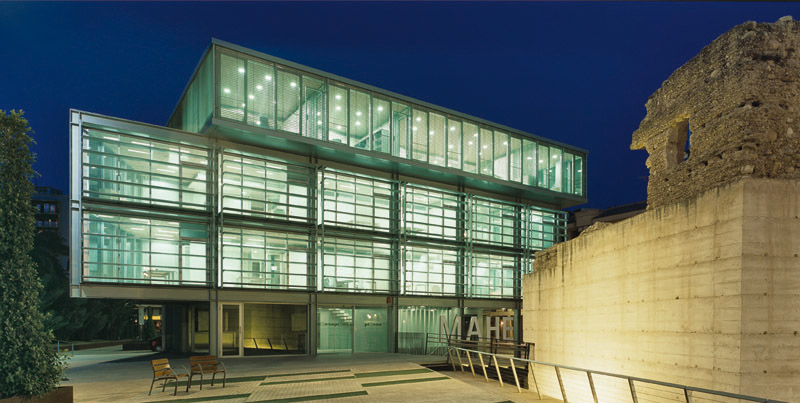 |
|
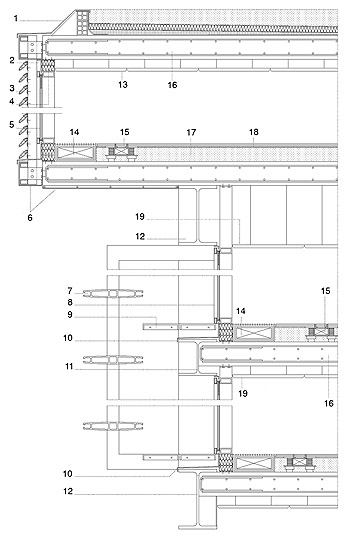 |
1. Panel composite de aluminio tipo alocubond/Aluminium composite panel, Alucobond type 2. Rematería de aluminio/Aluminium fascia 3. Lamas fijas de protección solar SUN-TEC (Shüco)/Fixed shading slats, SUN-TEC (Shüco) 4. Espuma de poliuretano/Polyurethane foam 5. Acristalamiento 3+3/cámara con persianilla/6 bajo emisivo/Low-emission glazing, 3+3/space with blind/6 6. Panel composite de aluminio/Aluminium composite panel 7. Lama móvil de protección solar/Movable shading slat 8. Carpintería FW50+/Joinery FW50+ 9. Perfil aluminio estructurado “Alcan”/Structured aluminium section, Alcan 10. Vierteaguas aluminio/Aluminium sill 11. HEB 300/HEB 300 12. HEB 500/HEB 500 13. Falso techo de Herakustic Star/Suspended ceiling, Herakustic Star 14. Aire acondicionado/Air conditioning 15. Canal instalaciones TDM/TDM installations duct 16. Losa de hormigón armado/Reinforced concrete floor slab 17. Hormigón celular/Foamed concrete 18. Parquet industrial/Heavy-duty parquet 19. Herakustic Star/Herakustic Star
|
|
|